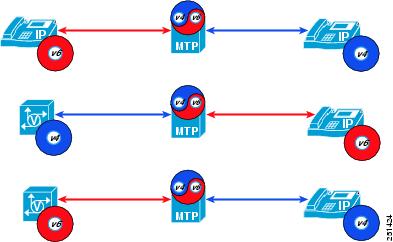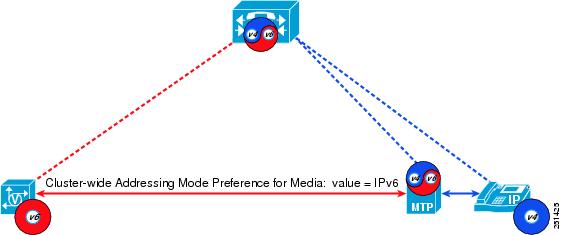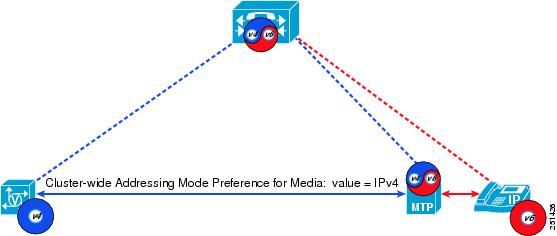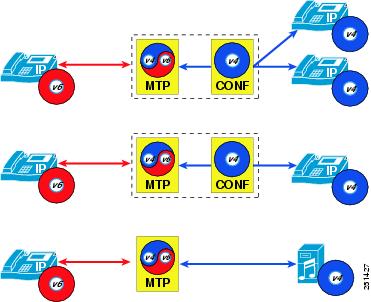

-
Deploying IPv6 in Unified Communications Networks with Cisco Unified Communications Manager
-
Preface
-
Introduction
-
IPv6 Basics
-
IPv6 Support in Cisco Unified Communications Devices
-
Unified Communications Deployment Models for IPv6
-
Network Infrastructure
-
Gateways
-
Trunks
-
Media Resources and Music on Hold
-
Call Processing and Call Admission Control
-
Dial Plan
-
Applications
-
IP Video Telephony
-
IP Telephony Migration Options
-
Security
-
Unified Communications Endpoints
-
Configuring IPv6 in Cisco Unified CM
-
Configuring Cisco Integrated Services Routers
-
Configuring Cisco VG224 Analog Voice Gateway
-
Configuring Cisco IOS Gateways
-
Table Of Contents
Media Resources and Music on Hold
IPv6 and Other Media Resources
Media Resources and Music on Hold
Revised: June 08, 2010; OL-19142-02
A media resource is a software-based or hardware-based entity that performs media processing functions on the data streams to which it is connected. Media processing functions include mixing multiple streams to create one output stream (conferencing), passing the stream from one connection to another (media termination point), converting the data stream from one compression type to another (transcoding), echo cancellation, signaling, termination of a voice stream from a TDM circuit (coding/decoding), packetization of a stream, streaming audio (Annunciator and Music on Hold), and so forth.
This chapter focuses on new media termination point (MTP) functionality introduced to support IPv6 Unified Communications deployments: namely, the capability of Cisco IOS MTPs to convert a voice media stream from IPv4 to IPv6 and vice versa. Other media resources such as conferencing and transcoding are also discussed in context with this new MTP functionality. For all other media resource and Music on Hold (MoH) design guidance, refer to the Cisco Unified Communications Solution Reference Network Design (SRND), available at http://www.cisco.com/go/ucsrnd.
Media Termination Point (MTP)
The following Cisco Integrated Services Router (ISR) MTPs support media conversion between IPv4 and IPv6 for devices with mismatched media IP address versions:
•
Cisco IOS hardware MTPs — Digital signal processors (DSPs) on the Cisco ISR Motherboard and NM-HDV2 with PVDM2 DSPs
•
Cisco IOS software MTPs
Cisco IOS Release 12.4(22)T supports the above MTPs.
Address Conversion Between IPv4 and IPv6
When a mismatch exists between the IP addressing versions supported by two devices, Unified CM dynamically inserts an MTP resource to convert the voice media stream from IPv4 to IPv6 and vice versa. Dynamically inserted MTPs support the pass-through codec, which allows the MTP to support not only voice calls but also video calls and encrypted calls. The pass-through codec should be configured on all dynamically inserted MTPs. To enable the use of the pass-through codec, configure the MTP with both a standard codec and the pass-through codec.
Unified CM trunks can also be configured with a statically assigned MTP (MTP Required check box checked). The trunk's statically defined MTP does not support the pass-through codec and supports only a single configured codec (G.711 or G.729), which limits all calls that use this trunk to either G.711 or G.729 voice calls and T.38 Fax calls only. This statically assigned MTP also has the capability to convert the voice media stream from IPv4 to IPv6 and vice versa.
To be dynamically or statically inserted into a call path, the Cisco IOS MTPs must be associated with the media resource group (MRG) for each device (phone or trunk).
The following Cisco IOS configuration is an example of a software MTP. The sccp local GigabitEthernet0/0 command associates the IPv4 and IPv6 addresses on this interface with the MTP for both SCCP signaling and media addresses.
interface GigabitEthernet0/0ip address 192.168.1.5 255.255.255.0! MTP's IPv4 addressipv6 address 2001:0db8:101:1:1::5/64! MTP's IPv6 address!sccp local GigabitEthernet0/0sccp ccm 192.168.0.15 identifier 1 version 7.0! Unified CM's IPv4 addresssccp ccm 2001: 0db8:101:1::15 identifier 2 version 7.0! Unified CM's IPv6 addresssccp!sccp ccm group 1associate ccm 1 priority 1associate ccm 2 priority 2associate profile 1 register MTP-1!dspfarm profile 1 mtpcodec g711ulawcodec pass-throughmaximum sessions software 100associate application SCCP!Figure 8-1 shows when an MTP is inserted between two devices to convert from IPv4 to IPv6, and vice versa. Note, however, that both devices can have MTP resources available in their media resource groups, and Unified CM must decide which MTP to use. Unified CM uses the cluster-wide setting of IP Addressing Mode Preference for Media to determine which MTP to use for conversions between IPv4 and IPv6. If the cluster-wide IP Addressing Mode Preference for Media is set to IPv6, Unified CM chooses the MTP associated with the IPv4 device (see Figure 8-2). Conversely, if the cluster-wide IP Addressing Mode Preference for Media is set to IPv4, Unified CM chooses the MTP associated with the IPv6 device (see Figure 8-3). By choosing the device whose addressing mode does not match the cluster-wide IP Addressing Mode Preference for Media, Unified CM selects the cluster-wide media preference value that will match the longest call leg between the two devices in the cluster.
Figure 8-1 MTP Insertion for Address Conversion Between IPv4 and IPv6
Figure 8-2 Unified CM Chooses MTP of the IPv4 Device
Figure 8-3 Unified CM Chooses MTP of the IPv6 Device
Note
If the preferred device's MTP is not available, the other device's MTP will be used as a last resort. If no MTPs are available, the call will fail.
Transcoder DSP resources can also be used as hardware MTPs. If both transcoding resources and software MTPs exist in the same media resource group, Unified CM uses these media resources in a round-robin fashion for conversions between IPv4 and IPv6. To prioritize transcoding DSP resources for transcoding purposes only, place the software MTP and hardware MTPs in a separate media resource group (MRG) and give this MRG precedence (a higher order) over the transcoder MRG in the media resource group list (MRGL).
IPv6 and Other Media Resources
The following media resources do not support IPv6 for voice. If these resources are invoked, an MTP resource is required to convert the voice stream between IPv6 and IPv4, as shown in Figure 8-4.
•
Audio conferencing
•
Video conferencing
•
Secure conferencing
•
Transcoding
•
Trusted Relay Point
•
Annunciator
•
Cisco IP Voice Media Streaming Application
•
Music on Hold (MoH)
Figure 8-4 MTP Inserted for Conversions Between IPv4 and IPv6
Voice conferencing resources and hardware MTP resources can reside on the same DSP. Similarly, voice transcoding resources and hardware MTP resources can reside on the same DSP.
IPv6-only devices do not support multicast music on hold
Cisco IOS RSVP Agent and IPv6
The Cisco IOS Resource Reservation Protocol (RSVP) agent does not support IPv6, and RSVPv4 cannot be used within the cluster for call admission control. For SIP trunks and intercluster trunks, locations-based call admission control must be used.
IPv4 to IPv6 Conversion When Multiple MTPs Exist within a Media Resource Group (MRG)
Unified CM server-based MTPs do not support the pass-through codec. If Cisco IOS MTPs (which support the pass-through codec) and Unified CM MTPs (which do not support the pass-through codec) are listed in the same media resource group, Unified CM requests an MTP with pass-through codec support for conversions between IPv4 and IPv6.
If an MTP is statically assigned to the SIP trunk (Early Offer), then conversions between IPv4 an dIPv6 can occur only for the codec specified on the MTP (G.711 or G.729).

 Feedback
Feedback



